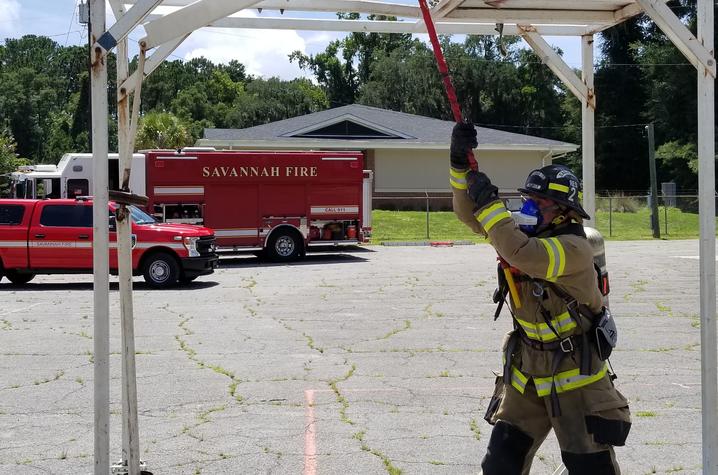Health Sciences, Education awarded $1.1 million FEMA grant to study firefighter injuries

Researchers from the University of Kentucky's College of Health Sciences and College of Education have received a $1.1 million grant from the Federal Emergency Management Agency (FEMA) to serve as principal investigators on a new study to promote injury mitigation, better work outcomes and a reduction in financial burdens for firefighters.
Mark Abel, Ph.D., from the College of Education and the First Responder Research Laboratory, Phillip Gribble, Ph.D., from the College of Health Sciences and the Sports Medicine Research Institute, and Nick Heebner, Ph.D., from the College of Health Sciences and the Sports Medicine Research Institute, are co-principal investigators for the three-year study, which began in September.
The trio aims to help firefighters reduce and minimize the burden of musculoskeletal injuries compromising their ability to perform occupational tasks safely and efficiently — and, by extension — promote this work to fire departments across the country.
“We hope to give them some support to invest and explain how their return on that investment will be worth it,” said Gribble, professor and chair of UK’s Department of Athletic Training and Clinical Nutrition. “There are, unfortunately, not as many of these efforts across the country as there should be.”
The study will incorporate departments of different sizes across the country, including those in Lexington, Denver, Sacramento and Savannah, among other cities. Gribble said the hypothesis is this: If firefighters have direct access to health care providers like athletic trainers and physical therapists, reportable musculoskeletal injuries will decrease, while work efficiency will increase. So, in half the participating departments, a health care professional is provided to the firefighter to aid in injury and prevention efforts. This is something that, in theory, will result in better and more efficient ways to prevent injuries, treat injuries before they get worse, and reduce associated workers’ compensation costs. In summary, the thinking is this is a much easier method of preventing and treating injuries. This is known as a “direct-care model.” The other half of the fire departments will utilize a traditional workers’ compensation only model.
Abel, a professor in the Department of Kinesiology and Health Promotion, previously served as a firefighter himself, and he has been integral in developing relationships with firefighters from around the globe. Two groups that have pledged support for the project include the International Association of Firefighters and International Association of Fire Chiefs (EMS Division).
“This is a real problem in the Fire Service that needs to be addressed,” Abel said. “The Fire Service traditionally uses the workers’ compensation model. Very few departments have integrated this direct-access model of having a health care provider on-site. So, if a firefighter has a few aches and pains, they may wait and not go through the hassle of contacting their general physician, which could take weeks, if they did decide to do so, and those aches and pains may linger and lead to an injury. Then you’re dealing with replacing that person, maybe paying overtime, etc. But with a healthcare provider on-site — a physical therapist or an athletic trainer — they could work with that person immediately and possibly prevent a more serious injury.”
But Abel was quick to point out that the key is the absence of any objective data for this direct-access model. And that is something the new study will be able to provide.
“If you can then show the leader of that municipality that there are cost savings, then they will have a justification to utilize the model,” said Heebner. “We’re expecting that the firefighters using direct access over these three years will have reduced costs, reduced time loss, less personnel backfilling and fewer reported injuries.”
The trio used what few statistics exist to make their initial argument, including that:
-
Annually about 60,000 injuries are incurred among firefighters, and about 65% of those do not occur at the fireground, indicating that the injuries occur during training or other activities.
-
Treating these injuries cost about $5.9 billion annually in the United States.
-
96% of companies that use a direct-access model in occupational settings report a reduction in workers’ comp claims of about 80%.
-
Companies using a direct-access model report a 3:1 ratio return on investment, meaning for every dollar they invest, they yield a $3 reduction in costs.
“The firefighter study highlights the value of combining expertise across the university’s colleges to make a difference,” said former UK College of Education Dean Julian Vasquez Heilig. “Together, we must ensure our research goes beyond journals to have meaningful impacts on the populations we study and serve. This study is a great example of how we can meet needs in communities by gaining impactful data via university-based research.”
UK College of Health Sciences Dean Scott Lephart agrees the firefighter study will benefit from the expertise and backgrounds of faculty in both colleges.
“This is another fine example of the important collaborative work being accomplished by our professors in the College of Health Sciences and the College of Education,” Lephart said. “In fact, you could say this is one of the most important examples, because this research will help firefighters save lives. The mission of our college is to help the people of the Commonwealth of Kentucky to achieve the highest level of health possible, and I can’t think of a better way to serve that mission than by conducting research like this. I want to convey a tremendous amount of gratitude and pride to all of those involved.”
Research reported in this publication was supported by the Federal Emergency Management Agency (FEMA) as part of an award EMW-2021-FP-00400 totaling $1,173,648 with 95.2% funded by FEMA and 4.8% funded by the University of Kentucky.
Credits
Text: Ryan Clark (Public Relations & Strategic Communication)
Photo: Mark Abel
